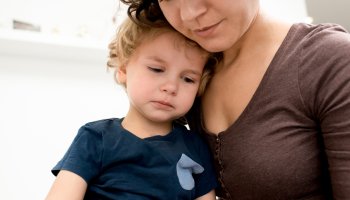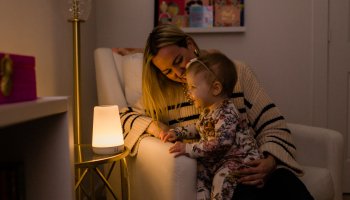
[ad_1]
Sudden Infant Death Syndrome, or SIDS, is a scary term to parents worldwide. It’s something that parents often hear about and truly hope it’s something that never happens to their family. Sudden Infant Death Syndrome is an unexplained and sudden death of a seemingly healthy baby that often occurs before the age of one. These infant deaths typically happen when a baby is sleeping and are also referred to as “crib death.”
For many years, researchers have been trying to identify the cause and risk factors for SIDS to prevent these deaths from occurring. While researchers haven’t been able to identify the exact cause of SIDS, there is new research that indicates SIDS deaths may be related to a combination of factors and that there are protective factors that families can keep in mind.
Risk Factors for SIDS
Some researchers have noted that SIDS may be related to a defect in a portion of infants’ brains that is related to breathing and arousing from sleep. Other risk factors include:
- being born prematurely
- low birth weight
- being exposed to cigarette smoke
- respiratory infections
- brain defects
- being a male
- non-white babies
- having SIDS deaths within the family
Researchers have also noted babies born to mothers who are younger than 20, drank alcohol/used substances during their pregnancy, or did not receive adequate care during the prenatal period may also be at higher risk of developing SIDS. In addition to these risk factors, significant environmental risk factors have been identified, which has led to the development of Safe Sleep Guidelines.
Protective Factors for SIDS
Many Safe Sleep Guidelines have been put into place to ensure that babies are sleeping in a safe sleeping environment to lower the risk of SIDS and other types of crib deaths such as suffocation or strangulation. In the United States, the Safe Sleep Guidelines are set by the American Academy of Pediatrics (AAP). Safe sleep guidelines include:
- Placing babies to sleep on their backs in a crib/bassinet.
- Breastfeeding your babies.
- Offering a pacifier.
- Avoid exposure to harmful toxins such as cigarette smoke.
- Having babies sleep on a firm flat surface, like a crib mattress.
- Their crib/bassinet (sleep space) is free of loose items like blankets, stuffed animals, crib bumpers, or other potentially dangerous products.
- Make sure babies are sleeping in a cool environment and are not at risk of overheating.
- Babies room-share with parents until at least six months old (and even up to 1 year) while avoiding bed-sharing.
While there are many things that we can do to ensure that our babies are sleeping in a safe environment and offer as many protective factors as possible, SIDS has remained a significant cause of infant deaths in Western countries. Research has continued to find out more about the causes of this syndrome.
New Groundbreaking Research
This week, groundbreaking research has come out of The Children’s Hospital at Westmead, in Australia, that has indicated that there may be a biochemical marker that plays a role in infants that have died of SIDS. Researchers completed a study in which they measured a biochemical marker, BChE, in infants 2-3 days after birth. The levels of BChE were significantly lower in babies that died due to SIDS than in babies who remained living or died from other reasons. These results are significant to note because this means that there is the possibility of identifying infants that are more at risk of developing SIDS and provides future research opportunities to identify potential interventions for these infants.
This research was led by Dr. Carmel Harrington, who has spent 29 years focused on finding answers about SIDS after losing her 2-year-old son, Damien. This study offers hope to many families with young babies, who may constantly worry about SIDS in the back (or front) of their minds. By identifying this biochemical marker, further interventions may be developed to help prevent SIDS deaths from occurring in those babies at risk.
What Does This Mean for Parents?
As a parent, it’s important to continue following the Safe Sleep Guidelines set out by your country to minimize your child’s risk of SIDS while taking precautions as best as possible. Keeping up to date with these guidelines, the SIDS risk factors, education, and protective factors, parents can help ensure they are equipped with the knowledge to best support their families. If you feel unsure of guidelines and ways to minimize your child’s risk, reach out to a trusted professional, such as a family doctor or pediatrician, to discuss further.
SIDS is a frightening cause of death for infants worldwide, and unfortunately, it has impacted many families. As a Pediatric Sleep Consultant, this new research is hopeful to share with families! While it’s important for families to remain cautious by following Safe Sleep Guidelines, this new study offers hope that there will be a way to identify infants at risk of SIDS. And with future research, there may be the potential to provide preventative support to families.
Resources
https://www.mayoclinic.org/diseases-conditions/sudden-infant-death-syndrome/symptoms-causes/syc-20352800
https://www.aap.org/en/news-room/news-releases/aap/2020/tips-for-keeping-infants-safe-during-sleep-from-the-american-academy-of-pediatrics/
https://www.cdc.gov/sids/about/index.htm
http://www.sleepforhealth.net.au/
https://reader.elsevier.com/reader/sd/pii/S2352396422002225?token=352F3A496BB5E074343FE1AB0B509E7B5684EE57DBCDD67B1A8535E4DAA81D5B8EB11247D65E737C75F8918D6263989F&originRegion=us-east-1&originCreation=20220513171255
https://www.cdc.gov/sids/data.htm
[ad_2]
Source link






